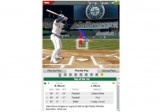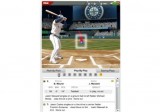Brandon Maurer, AB-by-AB
.
Q. What happened out there, from a technical standpoint?
A. There's an axiom in baseball. You read the hitter, and you pitch him accordingly:
- If he's amp'ed up - pull the string, throw offspeed.
- If he's passive - bust him with the fastball.
The Astros, as a lineup, were passive. They had fanned 9,000 times in an ugly first week, including a near-perfecto by Yu Darvish. After 20% swings and misses (!) they were dialed back, just trying to put the ball in play.
Maurer could have made hay with his 94-95 MPH fastball. Instead, he lobbed offspeed in there, and the Astros lined their little 150-foot pepper shots around the park.
I'm not making excuses. You want to know what actually happened, right?
.
Q. Prove it. We're hardly in any mood to take your word here.
A. Yep, Dr. D is going to need to provide data-rich environments for a while. :-) That's okay; when you go in like an unknown, having to prove yourself, it keeps you sharp. Heh!
Here, let's examine the base hits in the first inning, case-by-case. The first batter, Altuve. Maurer pounds him with two fastballs, 94 MPH, and quickly goes up 0-2. Then what happens?
You're Jose Altuve, you're 0-2 to a young flamethrower, and you're scared spitless of striking out. You're protecting the plate with a slider-speed bat.
Anything close, on an 0-2 count, you stick the arms out and you cover the pitch the best you can. On 0-2, you're not starting the bat early. You're getting a good look and then carefully getting the barrel to the ball.

Maurer throws an 87 MPH slider -- waist high -- onto the barrel of Altuve's bat. (Who squared it up and knocked a liner into RF for a single.)
Call me the next time you see Felix Hernandez throw a slider-speed pitch onto the outside third of the plate -- up -- with an 0-2 count.
We trust that the reader can see for himself that Maurer's pitch was the most brainless imaginable. If Maurer throws the same 0-2 pitch next time, and gets the plate again, to a singles hitter, he's going to see a dunker lined into right field again.
.
Q. Okay. Second hitter?
A. 94 MPH fastball to get ahead. That's fine, but look at the location:

Think of Justin Maxwell as a smaller Carlos Peguero. In his short stint in the bigs, he's been fine on fastballs and sliders, useless on curves and cutters, meaning that sophistication gives him issues. First pitch fastball, teed middle-middle.
Maxwell hit a sharp ground ball. It might have been a GIDP, or might have been a single. It was a single.
.
Q. Okay, two on, nobody out. What happened next?
A. Jason Castro ... Maurer throws three good pitches, and then on 2-1, doubles up an offspeed pitch with a second offspeed pitch, the blue one right in the middle of the cute little rectangle:

An 87 MPH pitch, bisecting the plate, exactly at the belt. That literally is a batting-practice pitch, and Castro smacked it into center field. As, probably, a pitcher would do if hitting against that pitch.
.
Q. Then Maurer struck out the next guy.
A. He struck out the right handed Chris Carter, yes, on four sliders and a fastball. The sliders clocked 88-89 MPH and did NOT bisect the plate:

.
Q. Pena ripped a double into the power alley.
A. This is the one AB all inning that is at all tough to decipher. Maurer threw two good fastballs on the hands, one right by him. Then he threw a quality changeup, away, a logical and effective ML pitch sequence. Pena torched it.
 that situation a high-away slider is just throwing the ball onto the barrel of his bat. (If he were amp'ed up for a fastball, then fine.)
that situation a high-away slider is just throwing the ball onto the barrel of his bat. (If he were amp'ed up for a fastball, then fine.)
Maurer was done after getting literally knocked out of the box; he walked a guy, gave up a single, and Wedge pulled the plug.
.
Q. So you'd give him another chance, or not?
A. Thusly...
NEXT